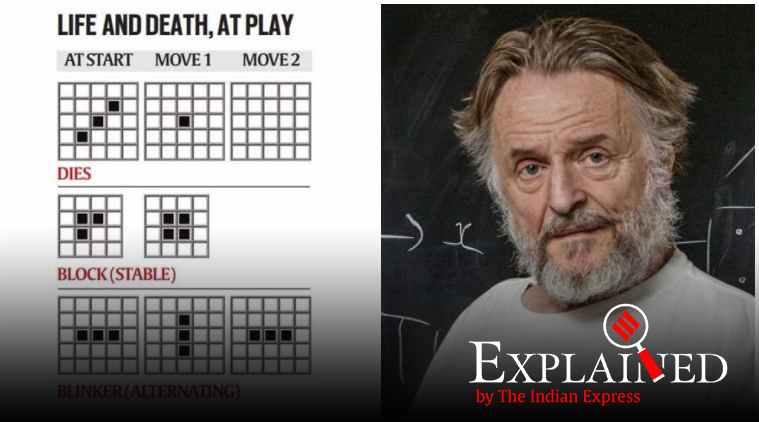Game of Life: the enduring legacy of John Conway, lost to coronavirus
John Horton Conway will be best remembered for the “Game of Life”, which he invented around 1970 and which continues, 50 years later, to fascinate people, including many who are not mathematicians.
 John Conway’s Game of Life (left). Cells in the top row die early; the middle pattern is stable after one generation; the bottom pattern alternates forever. (Adapted from Martin Gardner, Scientific American, October1970)
John Conway’s Game of Life (left). Cells in the top row die early; the middle pattern is stable after one generation; the bottom pattern alternates forever. (Adapted from Martin Gardner, Scientific American, October1970)
During the weekend, the English mathematician John Horton Conway, 82, died of COVID-19. He will be best remembered for the “Game of Life”, which he invented around 1970 and which continues, 50 years later, to fascinate people, including many who are not mathematicians.
What is the Game of Life?
It is a zero-player game, which means the game plays itself. Take an array of square cells, like a chessboard, but stretching infinitely in both the horizontal and vertical directions.
A cell may be either living or dead at any given time (but not both simultaneously). This status may or may not change in the next “generation”: A living cell can either stay alive or die; a dead cell can either stay dead or spring to life. The fate of a cell depends on its “neighbours” — the eight other cells that touch it horizontally, vertically or diagonally.
Conway wanted to make the behaviour of the “population” unpredictable. To achieve that, he weighed various options before finalising the following rules:
Survivals: If a living cell has two or three living neighbours, it survives for the next generation.
Deaths. If a living cell has four or more living neighbours, it dies from overpopulation. If it has only one living neighbour, or none, then it dies from isolation.
Births. If a dead cell has exactly three living neighbours — no more, no fewer — it springs to life in the next generation.
📢 Express Explained is now on Telegram. Click here to join our channel (@ieexplained) and stay updated with the latest
Why happens if a cell lives or dies?
Various patterns emerge of “life” and “death”. A few simple patterns are shown in the illustrations, adapted from Martin Gardner’s column in The Scientific American in October 1970. The three living cells placed diagonally (top row) reduce to one in the next generation, and then to none.
In the middle row, the three living cells help a fourth come to life, with which they form a “block” that remains unchanged in subsequent generations. In the bottom row is a “blinker”, which alternates between three cells living horizontally in one generation and three cells living vertically in the next.
Why do these make the game popular?
The examples here are among the simplest. The larger the configuration of living and dead cells, the more complex the subsequent patterns that form. One pattern called a “glider” (not shown in the illustrations), comprising five living and four dead cells placed in a 3×3 square, repeats itself every four generations, but slightly off from its previous position. Another pattern, the “F-pentomino”, keeps evolving until generation number 1,103, and then stabilises, Conway found. People are still discovering new patterns and the course they take.
Besides, Gardner took the game to a wide audience. His column, in 1957, also popularised the Game of Hex, created independently by the Danish mathematician Piet Hahn and the American John Nash.
What else is Conway’s legacy?
The Game of Life opened up a new field of mathematical research, in “cellular automata”. There are accounts, however, about Conway having been upset that this was what made him famous. Conway had many other contributions during the course of his career in Cambridge University and Princeton University. His research included knot theory, number theory and game theory.
Ian Stewart, 74, Professor Emeritus of Mathematics at the University of Warwick, was early in his career when he met Conway, in Cambridge. “He was famous then, partly because Martin Gardner had published a column on Conway’s amazing ‘Game of Life’… Mainly, he was famous because he was such an unusual and eccentric character, and a highly original thinker,” said Prof Stewart, by email.
What was unusual about him?
Prof Stewart recalled a “lively” lecture in 1966, as well as a mathematical trick with a long necklace of plastic beads. “If you held it in a particular way and poked one part through a gap, it made a knot. But when you tried to copy what (Conway) did — there was no such gap. What you didn’t notice was that he slowly twisted his hand while you were watching the necklace, and this twist created the gap. When you tried, you didn’t perform the twist, so there wasn’t a gap,” he said.
“He was always friendly and enthusiastic, and always had a new trick or toy. But he was also a brilliant research mathematician… His research is very diverse, very clever, and very unorthodox. John Conway was one of a kind, and the entire mathematical community will be saddened by his loss.”
Don’t miss these articles on Coronavirus from the Explained section:
‣ How coronavirus attacks, step by step
‣ Mask or no mask? Why the guidance has been shifting
‣ Besides a face cover, should I wear gloves when I go outdoors?
‣ How the Agra, Bhilwara and Pathanamthitta Covid-19 containment models differ
- 01
- 02
- 03
- 04
- 05






































